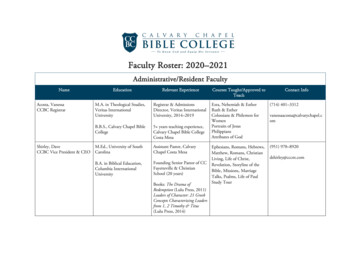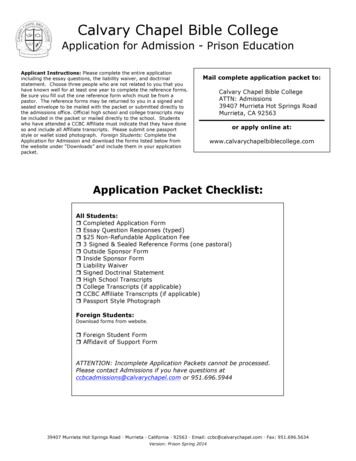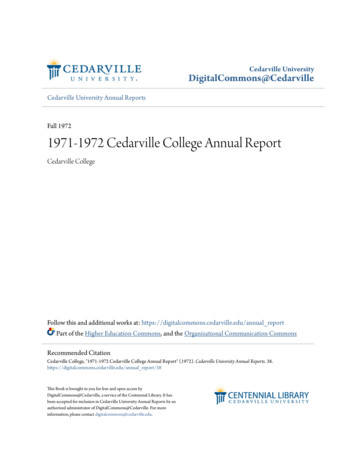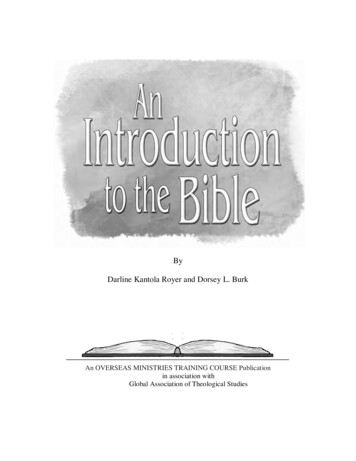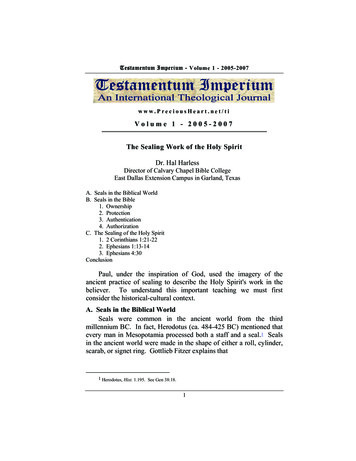
Transcription
Testamentum Imperium - Volume 1 - 2005-2007www.PreciousHeart.net/tiVolume 1 - 2005-2007The Sealing Work of the Holy SpiritDr. Hal HarlessDirector of Calvary Chapel Bible CollegeEast Dallas Extension Campus in Garland, TexasA. Seals in the Biblical WorldB. Seals in the Bible1. Ownership2. Protection3. Authentication4. AuthorizationC. The Sealing of the Holy Spirit1. 2 Corinthians 1:21-222. Ephesians 1:13-143. Ephesians 4:30ConclusionPaul, under the inspiration of God, used the imagery of theancient practice of sealing to describe the Holy Spirit's work in thebeliever. To understand this important teaching we must firstconsider the historical-cultural context.A. Seals in the Biblical WorldSeals were common in the ancient world from the thirdmillennium BC. In fact, Herodotus (ca. 484-425 BC) mentioned thatevery man in Mesopotamia processed both a staff and a seal.1 Sealsin the ancient world were made in the shape of either a roll, cylinder,scarab, or signet ring. Gottlieb Fitzer explains that1 Herodotus, Hist. 1.195. See Gen 38:18.1
Testamentum Imperium - Volume 1 - 2005-2007the material on which the seal was rolled or impressed was usually damploam or clay. This was then dried off in the air or baked in an oven. Wethus have many clay tablets with seals impressed, or vessels on which thehandles esp. bear the seal of the potter or the owner. When a documentwas sealed some clay was put on it and the seal could then be impressedon this. We do not have any examples of wax seals from antiquity.Scrolls, books and letters were sealed by sealing the tie which held themtogether.2Seals served as legal protection of property, proof of identity,authority, and accreditation.3 Reinier Schippers notes thatthe real importance of the seal is a legal one: the owner puts his mark onhis possessions, his beasts (cf. Virgil, Georgics 3, 157 ff.; BGU I, 87, 12f.; P. Teb. 419), his slaves (cf. Pliny, Nat. Hist. 25, 13, 173; BGU I, 15,etc.) and thereby guards his property against theft. To that extent onecan call it a protecting sign or a guarantee. When used with documents(wills, deeds of sale, etc.) the seal served as a signature to authorize whatwas written there (cf. TDNT VII 941). Things sealed were at the disposalof the possessor of the seal. This applied not only to private persons, butalso particularly to the authorities of a city and to kings. The sealsymbolized their authority.4The Scriptures attest to these uses of seals.B. Seals in the Bible1. OwnershipWhen the bridegroom in the Song of Solomon expresses to hisbeloved his desire that she give her love to him alone, he uses thefigure of a seal of ownership. He asks that she put him “like a sealover your heart, Like a seal on your arm” (Song 8:6 NASB5). Hementions love and jealousy as the reason for his request. She is to be2 Gottlieb Fitzer, “sphragis, sphragiz , katasphragiz ,” Theological Dictionary of the NewTestament (hereafter referred to as TDNT), ed. Gerhard Friedrich, trans. Geoffrey W. Bromiley, 10 vols.(Grand Rapids, MI: Eerdmans, 1971) 7: 939-40.3 Ibid. 7:941. See also Reinier Schippers, “Seal,” The New International Dictionary of NewTestament Theology (hereafter referred to as NIDNTT), ed. Collin Brown, 4 vols. (Grand Rapids, MI:Zondervan, 1986) 3:497-501; J. H. Moulton, G. Milligan, Vocabulary of the Greek Testament (London:Hodder and Stoughton, 1930; reprinted, Peabody, MA: Hendrickson, 1997) 617-18.4 NIDNTT 3:497.5 Gen. ed. Leland Ryken, James C. Wilhoit, Tremper Longman III, “Seal,” Dictionary of BiblicalImagery (hereafter referred to as DBI) (Downers Grove, IL: InterVarsity Press, 1998) 766.2
Testamentum Imperium - Volume 1 - 2005-2007sealed exclusively to him.confirming ownership.Thus, sealing serves the purpose of3
Testamentum Imperium - Volume 1 - 2005-20072. ProtectionSealing also refers to the protection of property in the Scriptures.Sealing protects items from tampering (Matt 27:66 [cf. Dan 6:18];Rom 15:28; Rev 20:3).6 In Revelation 5:1-8:1 the scroll of God’sjudgment is sealed with seven seals and cannot be opened until theLamb opens it (Rev 5:5). Schippers notes that “the number sevenrecalls the Roman custom of sealing wills with 7 seals .”7 Fitzerelaborates that “wills and testamentary dispositions were sealed bothby the testator and also the witnesses . Acc[ording] to Roman law 6witnesses had to sign and the will could be opened only when each ofthe 6 broke his own seal.”8 In a similar manner, in Jeremiah 32:44,deeds are signed and sealed to protect them from tampering. Sealingalso protects from disclosure (Isa 29:11; Rev 10:4; see also Dan 12:4,9; Rev 22:10;).9 Finally, sealing protects God’s people fromjudgment (Ezek 9:4; Rev 7:2-8; 9:4). Thus, one purpose of sealing isprotection.3. AuthenticationFitzer notes that “the seal also serves as proof of identity. It isput with a signature or in place of it in letters, agreements and privateor public instructions.”10As such, circumcision, as a seal,authenticates the inward faith that Abraham possessed (Rom 4:11).The image of sealing also refers to God’s approval (John 3:33; 6:27; 1Cor. 9:2). Schippers explains thatwhen Paul in 1 Cor. 9:2 calls the Corinthian community the seal of hisapostleship, he means that the existence of this community in the worldconfirms the legitimacy of his apostolic authority and that they are at thesame time his letters of recommendation (cf. 2 Cor. 3:1-3 ).116 DBI 766.7 NIDNTT 3:500.8 TDNT 7:941. See also Suetonius, Caes. 6.17.9 NIDNTT 3:500.10 TDNT 7:941. See also DBI 766.11 NIDNTT 3:499.4
Testamentum Imperium - Volume 1 - 2005-2007In a similar manner 2 Timothy 2:19 refers to God’s personalattestation to the truth. Thus, another purpose of sealing isauthentication.4. AuthorizationSince seals served as proof of identity, they also convey theauthorization of the seal owner.12 This custom is well attested inScripture (Gen 41:42; 1 Kgs 21:8; Neh 9:38; Esth 3:10,12; 8:2, 8, 10;Jer 22:24; 32:10, 14; 10:1; Dan 6:17; Hag 2:23) and the Apocrypha(1 Macc 6:15; 2 Esd 10:23). Flavius Josephus recounts the incidentwhere queen Helena in establishing one “Monobazus, the eldest son,to be king put the diadem upon his head, and gave him his father’sring, with its signet; and exhorted him to administer the affairs ofthe kingdom” (emphasis mine).13 Therefore, sealing also conveys theauthority of the owner of the seal. Against this background, let usnow consider the passages concerning the sealing ministry of theHoly Spirit.C. The Sealing of the Holy Spirit1. 2 Corinthians 1:21-22In the Greek, 2 Corinthians 1:21-22 is one sentence. Paul writes,“Now He who establishes us with you in Christ and anointed us isGod, ” (2 Cor 1:21 NASB). There is a play on words in Greekbetween “Christ” (christos, “the anointed one” from chriō, “toanoint”) and “anointed” (chrisas, the aorist active participle of chriō).Since the anointing is in the aorist tense, it should be seen as adefinitive past action. This occurred at the point that the Holy Spiritplaced the believer into union with Christ by means of the baptism ofthe Spirit (1 Cor 12:13). As we are in the Anointed One, we areourselves anointed ones.Grammatically, “He who establishes and anointed (ho bebaiōn kai chrisas)” is a Granville Sharp construction.14 TheGreek indicates that “He who establishes” and “[He who] anointedus” are the same person, namely God. “He who establishes”12 TDNT 7:941-42. See also DBI 766.13 Josephus, J. A. 20.2.2.14 Daniel B. Wallace, Greek Grammar Beyond the Basics (Grand Rapids, MI: Zondervan, 1996)270-75.5
Testamentum Imperium - Volume 1 - 2005-2007(bebaiōn) is the present active participle of bebaioō (“to establish”).Although we have been anointed as a definitive past action, we arecontinuously established.Many lexicographers take bebaioō (“to establish”) to mean“strengthen” when it is used of individuals.15 However, Psalms 40:13LXX has, “You set me in Your presence forever (ebebaiōsas meenōpion sou eis ton aiōna).” The construction bebaioō with eis seemsto mean, “to establish in a position.” G. Adolf Deissmann seesbebaioō as a legal guarantee of security.16 Thus, God’s establishingof believers is an objective work.Paul continues, “who also sealed us and gave us the Spirit in ourhearts as a pledge” (2 Cor 1:22). “Who sealed and gave (ho sphragisamenos kai dous)” is also a Granville Sharp construction.Grammatically, the sealer and the giver are the same person, againGod (2 Cor 1:22). “Who sealed (ho sphragisamenos)” is theaorist active participle of sphragizō (“to mark with a seal as a meansof identification, mark, seal”17). Fredrick Danker notes that “the markdenoting ownership also carries w[ith] it the protection of theowner.”18 Timothy and Barbra Friberg comment that sphragizō isused “metaphorically, as a commercial technical term indicating asafely accomplished transaction sphragizein tini ton karpon literallyseal to someone this fruit, i.e. safely turn over to someone this kindprovision (RO 15.28).”19 This is similar to the usage in Revelation7:3-8. Cleon L. Rogers, Jr. and Cleon L. Rogers III comment that“goods were sealed as a guarantee indicating not only ownership butalso the correctness of the contents.”20 Fitzer explains that15 Fredrick William Danker, “bebaioō,” A Greek-English Lexicon of the New Testament and otherEarly Christian Literature (hereafter referred to as BDAG), 3rd ed. (Chicago: University of ChicagoPress, 2000) 172-73; Joseph Henry Thayer, “bebaioō,” Greek-English Lexicon of the New Testament(reprinted, Grand Rapids, MI: Zondervan, 1962) 99-100; Timothy Friberg, Barbra Friberg, Neva F.Miller, “bebaioō,” Analytical Lexicon of the Greek New Testament (hereafter referred to as ALGNT)(Grand Rapids, MI: Baker, 2000) 89.16 G. Adolf Deissmann , Bible Studies: Contributions Chiefly from Papyri and Inscriptions to theHistory of the Language, the Literature, and the Religion of Hellenistic Judaism and PrimitiveChristianity, trans. Alexander Grieve (Edinburgh: T. & T. Clark, 1901; reprinted, Peabody, MA:Hendrickson, 1988) 104-9.17 BDAG 980.18 Ibid.19 ALGNT 371.20 Cleon L. Rogers, Jr., Cleon L. Rogers III, The New Linguistic and Exegetical Key to the GreekNew Testament (Grand Rapids, MI: Zondervan, 1998) 394.6
Testamentum Imperium - Volume 1 - 2005-2007in sealing believers — the apostle and the church in Corinth — God hasmade them His own inviolable possession; the pledge of this is the Spiritof God in the heart, cf. R. 5:5. There is a variation on 2 C. 1:22 in Eph.1:13 f. and 4:30. The Holy Spirit as the pledge of the inheritance is nowthe seal with which the believer is marked, appointed and kept for theredemption. It shows that he is God’s possession to the day ofredemption.21Craig S. Keener notes thatdocuments and jars of merchandise were sealed to show that no one hadtampered with their contents. The stamp of the person witnessing adocument would be pressed into the hot wax, which then dried over thestring tied around the rolled-up document. Paul means that God attestedthe contents of the ministry of himself and his colleagues (cf. 3:2-3).22Deissmann comments, “Our conjecture is that the sealing of thesacks of fruit was to guarantee the correctness of the contents. If thefruit is sealed, then everything is in order: the sealing is the last thingthat must be done prior to delivery.”23 Thus, the Holy Spirit’s sealingministry not only marks the believer as God’s own possession, butalso guarantees the believer’s safe delivery to the day of redemption.No tampering with the contents will be tolerated under the authorityof God Himself!The Spirit in our hearts is a pledge. God “gave us the Spirit inour hearts as a pledge (ton arrabōna tou pneumatos en tais kardiashēmōn)” (2 Cor 1:22). Henry Alford explains that “the Spirit (toupneumatos)” is a genitive of apposition. It should be translated, “thepledge, which is the Spirit.”24 Keener notes thatJudaism generally associated the Spirit with the end of the age (e.g.,Ezek 39:28-29; Joel 2:28); Paul says that they had the Spirit in thepresent as a “down payment” (“pledge”—NASB; “deposit”—NIV; “firstinstallment”—NRSV), the first taste of the life of the world to come.25Lawrence O. Richards explains that21 TDNT 7:949.22Craig S. Keener, The IVP Bible Background Commentary : New Testament (hereafter referred toas BBCNT) (Downers Grove, IL: InterVarsity, 1993) 495.23 Deissmann, Bible Studies 238-39.24 Henry Alford, Alford's Greek Testament: An Exegetical and Critical Commentary, 5 vols.(reprinted, Grand Rapids, MI: Guardian, 1976) 2:635.25Keener, BBCNT 495.7
Testamentum Imperium - Volume 1 - 2005-2007God’s Spirit is an arrabon. The word is drawn from the world ofcommerce, and means a deposit made on goods, which serves as aguarantee that full payment will be made and the goods will be collectedby the buyer.God has purchased us in Christ to be His own precious possession. TheHoly Spirit is with us as a arrabon, assuring us that at history’s end Godwill surely collect us as His own.26Therefore, not only are believers sealed so as to be safely delivered tothe day of redemption, they have received the deposit of the HolySpirit that guarantees that the redemption will certainly be received.2. Ephesians 1:13-14Here again the Greek for at least Ephesians 1:13-14, and perhapsEphesians 1:3-14, is one sentence. Paul writes of the believer’sposition in Christ, “In Him, you also, after listening to the message oftruth, the gospel of your salvation—having also believed, you weresealed in Him with the Holy Spirit of promise” (Eph 1:13 NASB).This gives us an important clue about the timing of the sealingministry of the Holy Spirit. The passage has two aorist activeparticiples: “after listening” (akousantes, from akouō, “to hear”) and“having also believed” (pisteusantes, from pisteuō, “to trust,believe”). Daniel B. Wallace notes thatthe aorist participle is normally, though by no means always, antecedentin time to the action of the main verb. But when the aorist participle isrelated to an aorist main verb, the participle will often becontemporaneous (or simultaneous) to the action of the main verb.27Since the main verb “you were sealed” (esphragisthēte) is theaorist passive of sphragizō (“to seal”), we should understand that thesealing is simultaneous with the hearing and believing. Wallacecomments thatAlthough it is certainly possible to translate this last text as “after hearing after believing you were sealed,” both the grammatical possibility ofcontemporaneity and the overall context lead me to believe that the aoristparticiple is contemporaneous here. Contextually, the threefold praise tothe Godhead is in the first two instances due to God's prior action(election, redemption). To be consistent, it should be this way for the26 Ibid.27 Wallace, Greek Grammar Beyond the Basics 624.8
Testamentum Imperium - Volume 1 - 2005-2007third leg (in the least, sealing should not follow believing). Further, inthe following context (2:1-10), this theme of God's saving grace is givengreater articulation. The metaphor of death in that passage as the statefrom which the elect were delivered gives no confidence that conversionprecedes regeneration.28Both the ESV and the NRSV translate this “when” not “after.”Therefore, the sealing of the believer by the Holy Spirit occurssimultaneously with hearing the gospel and believing.Here also the believer is described as “sealed.” However, thebeliever is not merely sealed, but sealed “in Him [i.e., Christ]”. It isour relationship with Christ that will be preserved intact. Richardsexplains thatin the Hellenistic world, a man’s seal, a carved insignia pressed in wax,had legal significance. Stamped on possessions the seal indicatedownership and served as a ward against theft. On a document, the sealauthenticated the message it contained, and symbolized the full authorityof the person who sent it. Further, a sealed document could be openedonly by the one to whom it was addressed.Paul here portrays the Holy Spirit as God’s seal, stamped on the heart ofthe believer. The Spirit marks us as God’s own, and places us under Hisprotection, guaranteeing that we can be delivered to God, the One who inChrist has destined us as His own.29This sealing is accomplished “with the Holy Spirit (tō pneumati)of promise” (Eph 1:13 NASB). A. T. Robertson sees this as aninstrumental dative.30 Wallace further defines this as a dative ofmeans.31 That is, the sealing is accomplished by means of the HolySpirit. Clinton E. Arnold comments:In some cases, people declared themselves the possession of a deity bythe imprint of a seal. The one true God has also marked his possessionby means of a seal, yet his seal does not leave a physical impression. He28 Ibid. 625.29 Lawrence O. Richards, The Victor Bible Background Commentary: New Testament (ColoradoSprings, CO: Cook, 1994) 465.30 Archibald Thomas Robertson, Word Pictures in the New Testament, 6 vols. (Nashville, TN:Broadman, 1931) 4:519.31 Wallace, Greek Grammar Beyond the Basics 166.9
Testamentum Imperium - Volume 1 - 2005-2007has given his people the gift of the Holy Spirit as a sign of theirbelonging to him.32The Holy Spirit is called “the Holy Spirit of promise (tō pneumatitēs epangelias)” (Eph 1:13 NASB). The phrase “of promise”(pneumati tēs epangelias) is an attributive genitive and means “thepromised Holy Spirit” (Eph 1:13 NET).33 Therefore, simultaneouswith hearing and believing the gospel, believers are sealed in theirrelationship in Christ by means of the promised Holy Spirit.The Holy Spirit is again (cf. 2 Cor 1:22) referred to as He “who isgiven as a pledge of our inheritance” (Eph 1:14 NASB). Keenercomments:A wax seal would have a mark of ownership or identification stamped init, identifying who was attesting what was inside the container that hadbeen sealed. Because it was commonly understood that the Spirit wouldbe made especially available in the time of the end, Paul here speaks ofthe Spirit as a “deposit” (NIV)—a term used in ancient businessdocuments to mean a “down payment.” Those who had tasted the Spirithad begun to taste the life of the future world that God had promised hispeople.34Because the Holy Spirit has been given to believers, they can haveabsolute assurance that they will receive their inheritance.3. Ephesians 4:30Our final reference to the Holy Spirit’s sealing work is interestingin that it occurs in a context of admonition. Paul writes that weshould “not grieve the Holy Spirit of God, by whom you were sealedfor the day of redemption” (Eph 4:30 NASB). Paul has justadmonished the Ephesians to avoid several sins and will continueadmonishing them concerning others (Eph 4:25-31). Against thisbackdrop, Paul reminds the Ephesians of the very real danger ofgrieving the Holy Spirit. Nevertheless, Paul does not question thatthey were “sealed for the day of redemption” (Eph 4:30 NASB).Indeed, Paul based his admonition on that fact!32 Clinton E. Arnold, “Ephesians,” Zondervan Illustrated Bible Backgrounds Commentary, gen.ed. Clinton E. Arnold, 4 vols. (Grand Rapids, MI: Zondervan, 2002) 3:308. See also J. H. Bernard, “TheSecond Epistle to the Corinthians,” The Expositor's Greek Testament, ed. W. Robertson Nicoll, 5 vols.(reprinted, Grand Rapids, MI: Eerdmans, 1990) 3:46; Herodotus, Hist. 2:113; 3 Macc 2:29-30.33 Wallace, Greek Grammar Beyond the Basics 86-88.34 Keener, BBCNT 542.10
Testamentum Imperium - Volume 1 - 2005-2007“You were sealed” (esphragisthēte) is the aorist passive ofsphragizō (“to seal”). This is a definitive past action in which thebeliever is the passive recipient. This sealing is “for the day ofredemption (eis hēmeran apolutrōseōs)” (Eph 4:30 NASB). Thepreposition eis may be temporal (“unto”) or reference (“for”). Eithertranslation indicates that the believer will be delivered intact to theeschatological day of redemption (cf. Rom 8:23). As Robert GlennGromacki comments:A believer is sealed “unto the day of redemption” (Eph 4:30). The Spiritis the seal. A seal is a sign of ownership and authority. God has stampedor branded us with the Holy Spirit. His indwelling presence is the signthat we belong to Him and that we are under His authority.35Thus, although believers may sin and grieve God’s Holy Spirit,that same Holy Spirit nonetheless seals them unto the day ofredemption.ConclusionIt appears that “the image of God’s sealing his people combinesall these meanings—authenticity, ownership, mystery, worthiness,preservation .”36 The Holy Spirit’s sealing ministry not only marksthe believer as God’s own possession, but also legally guaranteesunder God’s own authority the believer’s safe delivery to the day ofredemption. Because God has given the deposit of the Holy Spirit tobelievers, they can have absolute legal assurance that they will receivetheir inheritance. Simultaneous with hearing and believing thegospel, believers are sealed in their relationship in Christ by means ofthe promised Holy Spirit. Believers may sin and grieve God’s HolySpirit. Nonetheless, they remain sealed unto the day of redemption.Thus, the sealing ministry of the Holy Spirit establishes a firmfoundation for the security of the believer.35 Robert Glenn Gromacki, Salvation is Forever (Chicago: Moody, 1973) 57.36 DBI 766.11
Director of Calvary Chapel Bible College East Dallas Extension Campus in Garland, Texas A. Seals in the Biblical World B. Seals in the Bible 1. Ownership 2. Protection 3. Authentication 4. Authorization C. The Sealing of the Holy Spirit 1. 2 Corinthians 1:21-22 2. Ephesians 1:13-14 3. Ephesians 4:30 Conclusion
